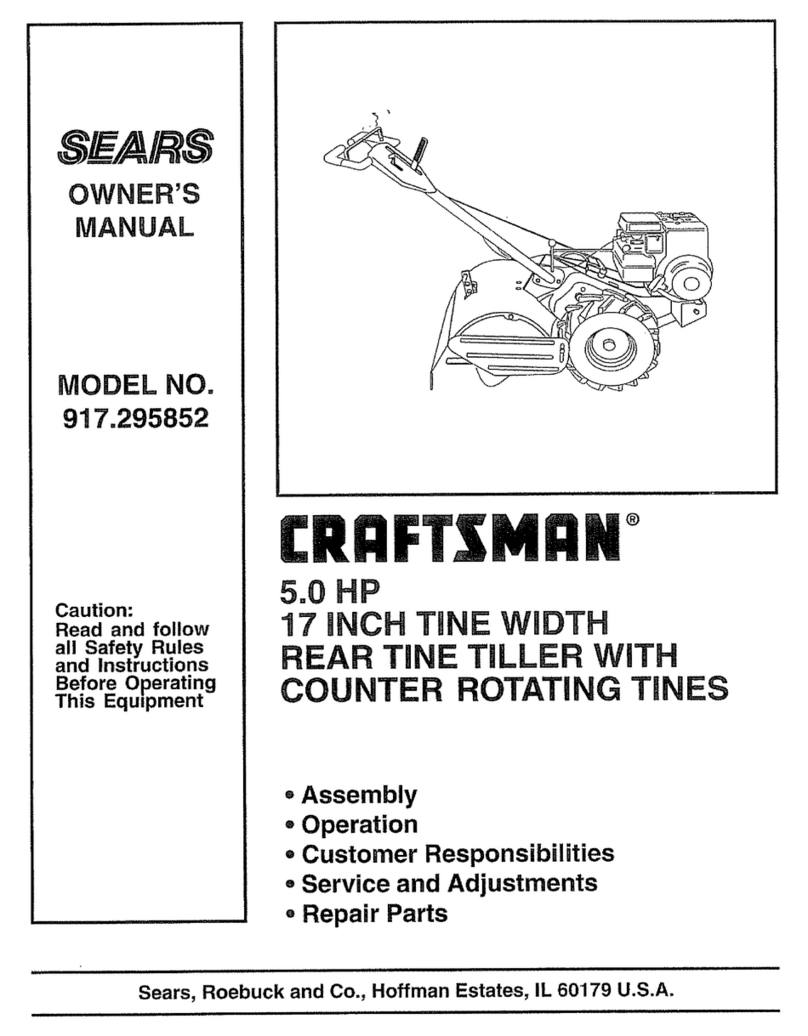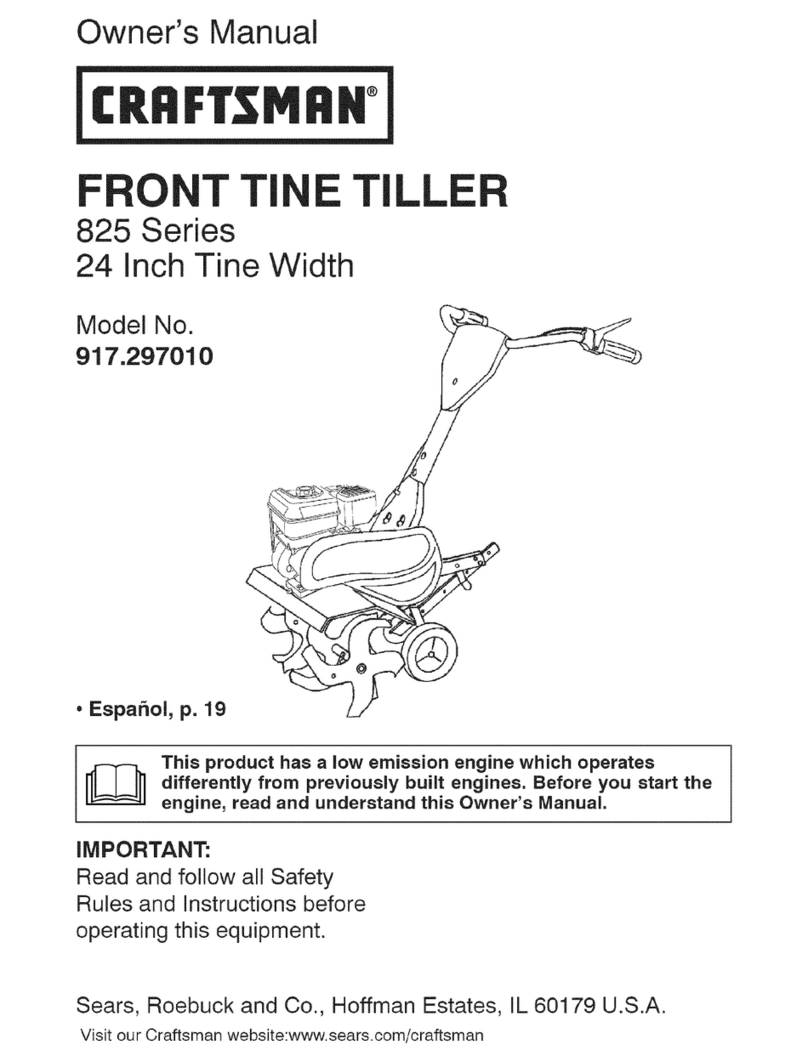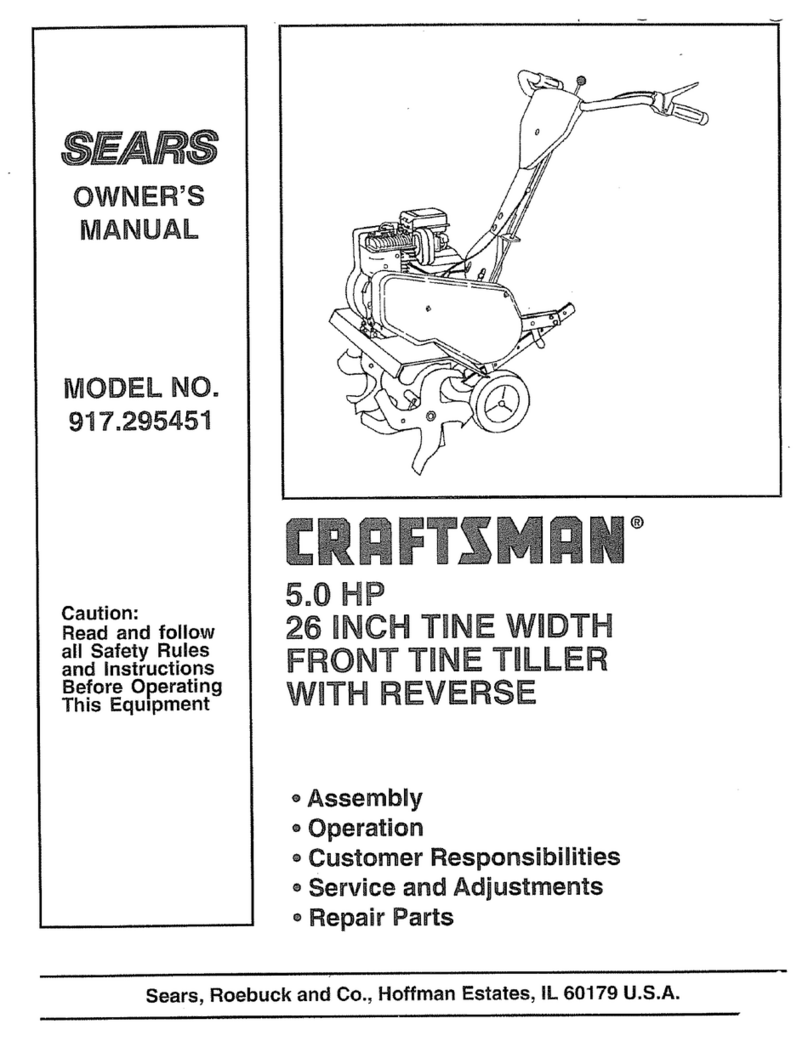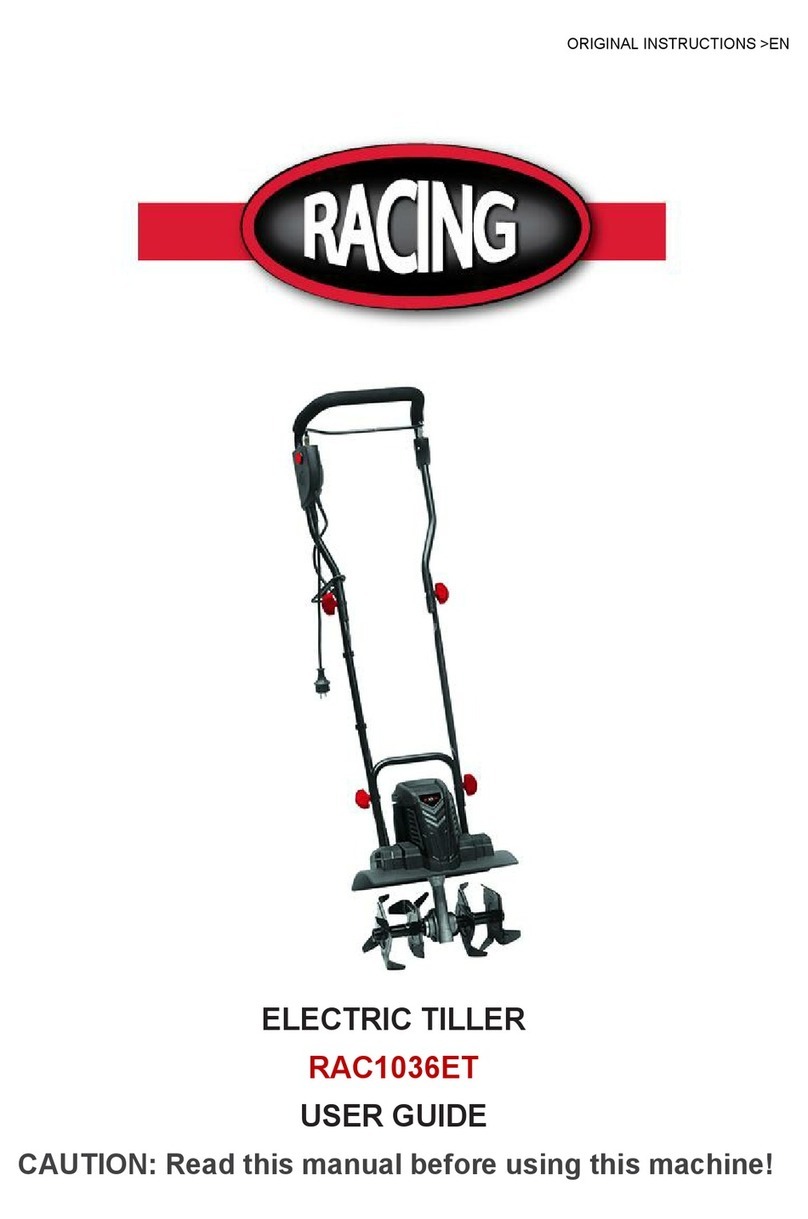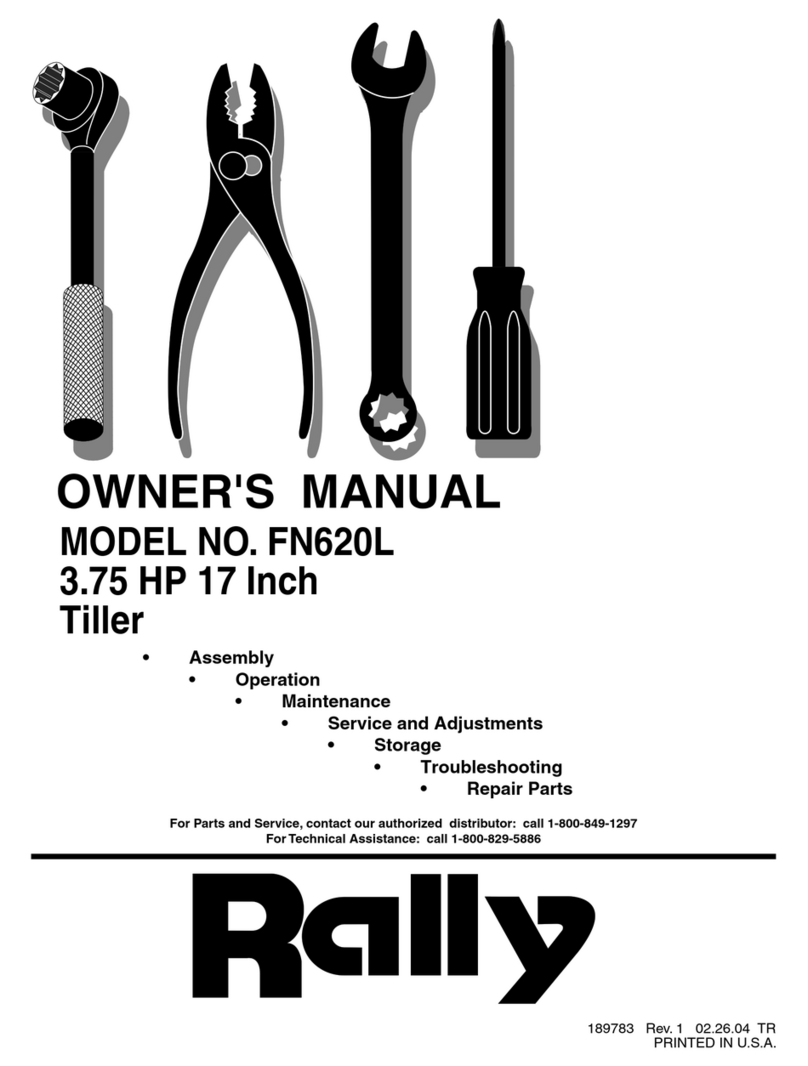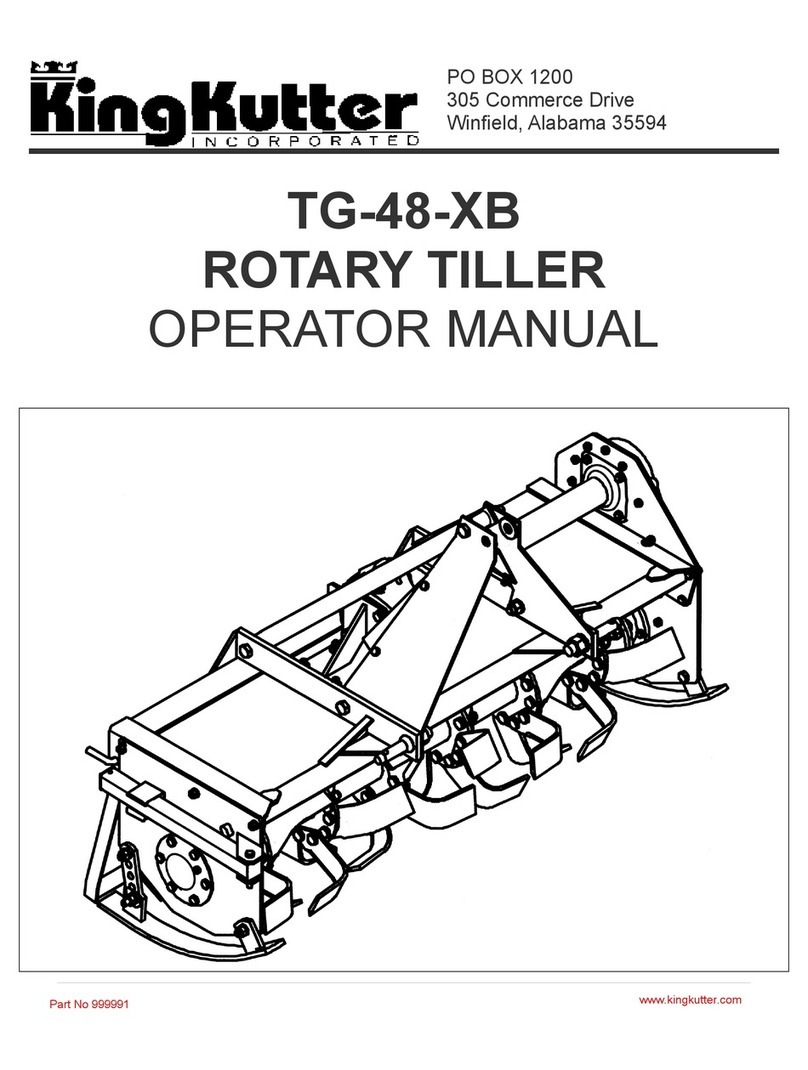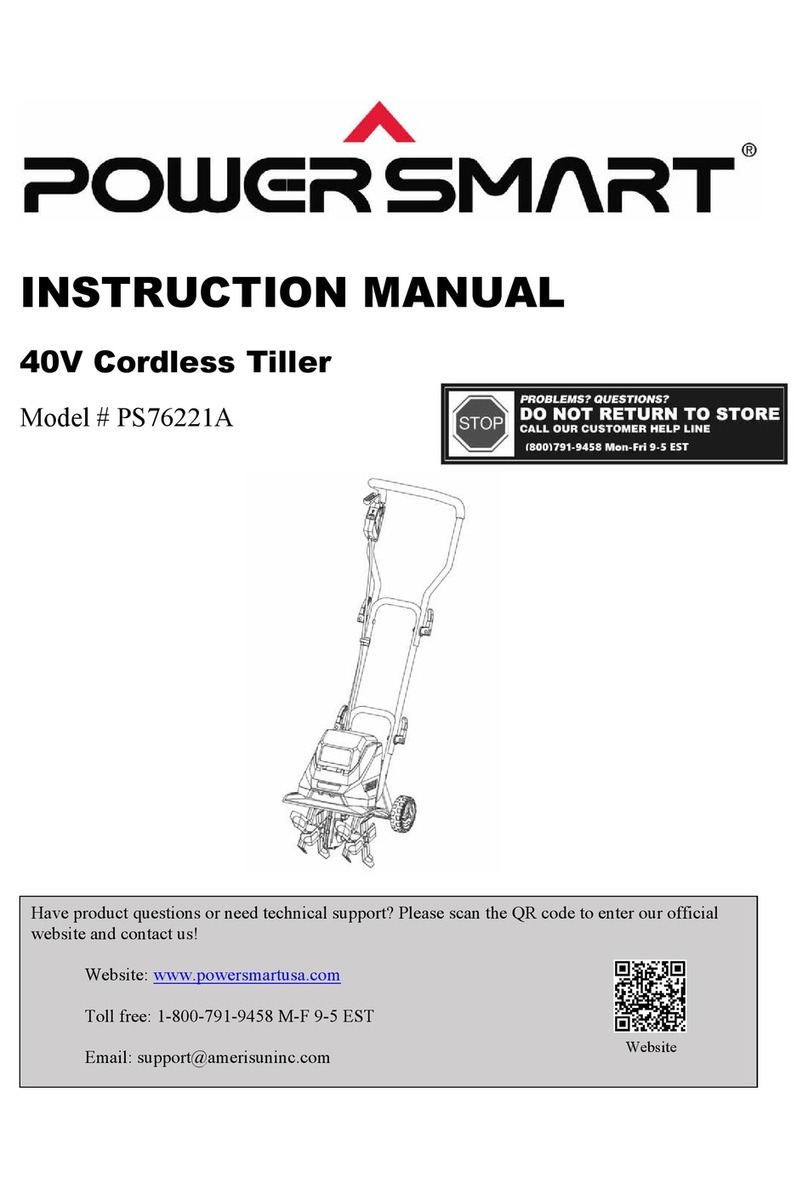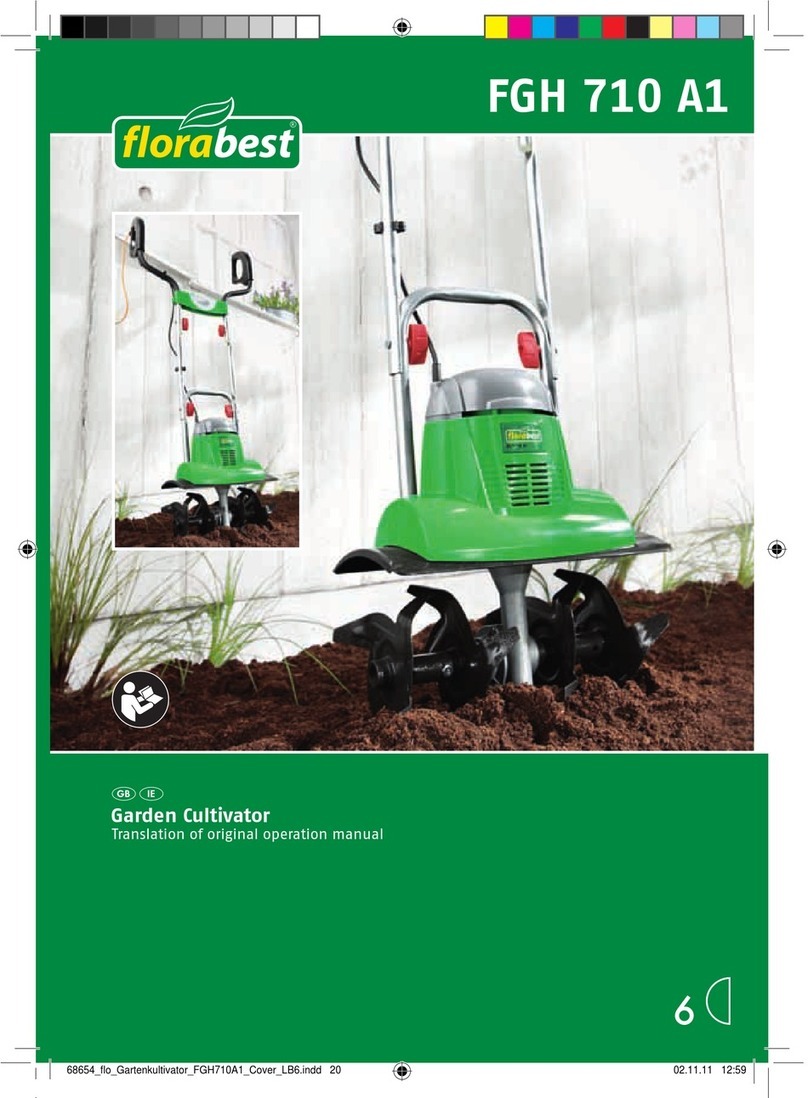BE Ag & Industrial BE-BRT Series Application guide

PURCHASE DATE MODEL NO. SERIAL NUMBER
DEALER
GASOLINE TILLER
BE-BRTXXX
OPERATIONS & PARTS MANUAL
FOR MODELS:
• BE-BRTH65
• BE-BRTR7
MANUAL CODE 102.108C

TABLE OF CONTENTS
3SAFETY
7ASSEMBLY
9OPERATION
13 MAINTENANCE & STORAGE
17 STORAGE & TROUBLESHOOTING
19 PARTS LIST

BE-BRTXXX USER MANUAL 3
SAFETY
OWNER’S RESPONSIBILITY
Accurate assembly and safe and eective use of the rototiller is the owner’s responsibility.
• Read and follow all safety instructions.
• Carefully follow all assembly instructions.
• Maintain the tiller according to directions and schedule included in this operator’s manual.
• Ensure that anyone who uses the tiller is familiar with all controls and safety precautions.
SPECIAL MESSAGES
Your manual contains special messages to bring attention to potential safety concerns, machine damage as
well as helpful operating and servicing information.
Please read all the information carefully to avoid injury and machine damage.
NOTE: General information is given throughout the manual that may help the operator in the operation or
service of the machine.
IMPORTANT SAFETY PRECAUTIONS
Please read this section carefully.
Operate the tiller according to the safety instructions and recommendations outlined here and inserted
throughout the text. Anyone who uses this tiller must read the instructions and be familiar with the controls.
Your tiller is equipped with a safety device that enables you to stop the wheels and tines quickly in an
emergency.
Learn how the drive safety control lever operates and how to control the tiller at all times.
This symbol points out important safety instructions which if not followed could
endanger your personal safety. Read and follow all instructions in this manual before
attempting to operate this equipment.
DANGER
INDICATES A SERIOUS INJURY OR FATALITY WILL RESULT IF THE SAFETY INSTRUCTIONS THAT
FOLLOW THIS SIGNAL WORD ARE NOT OBEYED
WARNING
INDICATES A SERIOUS INJURY OR FATALITY COULD RESULT IF THE SAFETY INSTRUCTIONS THAT
FOLLOW THIS SIGNAL WORD ARE NOT OBEYED
CAUTION
INDICATES YOU CAN OR YOUR EQUPMENT CAN BE HURT IF THE SAFETY INSTRUCTIONS THAT
FOLLOW THIS SIGNAL WORD ARE NOT OBEYED
IMPORTANT
INDICATES HELPFUL INFORMATION FOR PROPER ASSEMBLY, OPERATION, OR MAINTENANCE OF
YOUR EQUIPMENT
WARNING
YOU MUST READ, UNDERSTAND AND COMPLY WITH ALL SAFETY AND OPERATING INSTRUCTIONS IN
THIS MANUAL BEFORE ATTEMPTING TO SETUP AND OPERATE YOUR ROTOTILLER
FAILURE TO COMPLY WITH AL LSAFETY AND OPERATION INSTRUCTIONS CAN RESULT IN LOSS OF
THE MACHINE CONTROL, SERIOUS PERSONAL INJURY TO YOU AND/OR BYSTANDERS, AND RISK OF
EQUIPMENT AND PROPERTY DAMAGE. THE TRIANGLE IN THE TEXT SIGNIFIES IMPORTANT CAUTIONS
OR WARNINGS WHICH MUST BE FOLLOWED.
CALIFORNIA PROPOSITION 65 WARNING
ENGINE EXHAUST FROM THIS PRODUCT CONTAINS CHEMICALS KNOW TO THE STATE OF CALIFORNIA
TO CAUSE CANCER, BIRTH DEFFECTS, OR OTHER REPRODUCTIVE HARM.

4 BE-BRTXXX USER MANUAL
• Do not allow children to operate this rototiller. Keep small children away from the area being tilled. Do not
allow adults to operate the tiller without proper instruction.
PREPARATION
• Dress appropriately when operating the tiller. Always wear sturdy footwear. Never wear sandals, sneakers,
or open shoes, and never operate the tiller with bare feet. Do not wear loose clothing that might get
caught in moving parts.
• Carefully inspect the area to be tilled and remove all foreign objects. Do not till above underground water
lines, gas lines, electric cables, or pipes. Do not operate the tiller in soil with large rocks and foreign objects
which can damage the equipment.
• Disengage all clutches and leave all control levers in the neutral position before starting the engine.
• Handle fuel with care; it is highly flammable.
• Use an approved fuel container.
• Never add fuel to a running engine or hot engine.
• Fill fuel tank outdoors with extreme care. Never fill fuel tank indoors.
• Replace gasoline cap securely and clean up spilled fuel before restarting.
• Never attempt to make any adjustments while the engine is running.
OPERATION
• Never operate the tiller without guards, covers, and hoods in place.
• Never start the engine or operate the tiller with the wheels in the free-wheel position.
Make sure the wheel lock pins are engaged through the wheel hubs and wheel axle. The wheels act as a
brake to keep the tiller at a controlled speed. Disengage wheel lock pins to permit free-wheeling only when
engine is stopped.
• Keep hands, feet, and clothing away from rotating parts. Keep clear of tiller tines at all times.
• Tines and wheels rotate when tiller is engaged in forward or reverse-- in forward, tines and wheels rotate
when the drive safety control lever (FORWARD), is pushed down toward the handlebar. In reverse, wheels
and tines rotate when the drive safety control lever (REVERSE), is pulled back toward the operator.
Releasing the reverse handle to the neutral position stops the wheels and tines. Do not operate both drive
safety control levers at the same time.
• Be extremely cautious when operating in reverse. Take extra care to avoid slipping or falling, and keep
hands and feet clear of tines.
• Use extreme caution when operating on or crossing gravel drives, walks, or roads. Stay alert for hidden
hazards or trac.
• Do not allow children to operate this rototiller. Keep small children away from the area
being tilled. Do not allow adults to operate the tiller without proper instruction.
PREPARATION
• Dress appropriately when operating the tiller. Always wear sturdy footwear. Never wear
sandals, sneakers, or open shoes, and never operate the tiller with bare feet. Do not wear
loose clothing that might get caught in moving parts.
• Carefully inspect the area to be tilled and remove all foreign objects. Do not till above
underground water lines, gas lines, electric cables, or pipes. Do not operate the tiller in soil
with large rocks and foreign objects which can damage the equipment.
• Disengage all clutches and leave all control levers in the neutral position before starting
the engine.
• Handle fuel with care; it is highly flammable.
a. Use an approved fuel container.
b. Never add fuel to a running engine or hot engine.
c. Fill fuel tank outdoors with extreme care. Never fill fuel tank indoors.
d. Replace gasoline cap securely and clean up spilled fuel before restarting.
• Never attempt to make any adjustments while the engine is running.
OPERATION
• Never operate the tiller without guards, covers, and hoods in place.
• Never start the engine or operate the tiller with the wheels in the free-wheel position.
Make sure the wheel lock pins are engaged through the wheel hubs and wheel axle. The
wheels act as a brake to keep the tiller at a controlled speed. Disengage wheel lock pins to
permit free-wheeling only when engine is stopped.
• Keep hands, feet, and clothing away from rotating parts. Keep clear of tiller tines at all
times.
• Tines and wheels rotate when tiller is engaged in forward or reverse-- in forward, tines
and wheels rotate when the drive safety control lever(FORWARD), is pushed down toward
the handlebar. In reverse, wheels and tines rotate when the drive safety control
lever(REVERSE), is pulled back toward the operator. Releasing the reverse handle to the
neutral position stops the wheels and tines. Do not operate both drive safety control levers
at the same time.
• Be extremely cautious when
operating in reverse. Take extra care
to avoid slipping or falling, and keep
hands and feet clear of tines.
• Use extreme caution when operating
on or crossing gravel drives, walks, or
roads. Stay alert for hidden hazards or
traffic.
• After striking a foreign object, stop the engine, remove the wire from the spark plug, thoroughly inspect
the tiller for any damage, and repair the damage before restarting and operating the tiller.
• If vegetation clogs the tines, raise the handlebars to elevate the tines, and run the tiller in reverse. If this
does not clean clogged vegetation from the tines, STOP THE ENGINE AND DISCONNECT THE SPARK
PLUG WIRE before removing vegetation by hand.
• Engine muer will be hot from operation. Do not touch it with bare skin or a severe burn may result.
• If the unit should start to vibrate abnormally, stop the engine and check immediately for the cause.
Vibration is generally a warning of trouble.

BE-BRTXXX USER MANUAL 5
• Do not run the engine indoors; exhaust fumes are deadly.
• Do not overload the machine capacity by attempting to till too deep at too fast a rate.
• Never operate the machine at high transport speeds on slippery surfaces. Look behind and use care when
backing.
• Never allow bystanders near the unit.
• Use only attachments and accessories approved by the manufacturer of the tiller.
• Never operate the tiller without good visibility or light.
• Be careful when tilling in hard ground. The tines may catch in the ground and propel the tiller backward. If
this occurs, let go of the handlebars and do not restrain the machine.
• Take all possible precautions when leaving the machine unattended. Disengage all control levers, stop the
engine, wait for all moving parts to stop, and make certain guards and shields are in place.
• When leaving the operating position for any reason:
• shut o the engine.
• wait for all moving parts to stop.
MAINTENANCE AND STORAGE
• Keep machine, attachments, and accessories in safe working condition.
• Check shear bolts, engine mounting bolts, and other bolts at frequent intervals for proper tightness to be
sure the equipment is in safe working condition.
• To prevent accidental starting, always disconnect and secure the spark plug wire from the spark plug
before performing tiller maintenance.
• Never run the engine indoors. Exhaust fumes are deadly.
• Always allow muer to cool before filling fuel tank.
• Never store equipment with gasoline in the tank inside a closed building where fumes may reach an open
flame or spark. Allow the engine to cool before storing in any building.
• Always refer to the operator’s guide instructions for important details if the tiller is to be stored for an
extended period.
SAFETY DECALS
This rototiller unit has been designed and manufactured to provide you with the safety and reliability you
would expect from an industry leader in outdoor power equipment manufacturing.
Although reading this manual and the safety instructions it contains will provide you with the necessary
basic knowledge to operated this equipment safely and eectively, we have placed several safety labels on
the tiller to remind you of this important information while you are operating the unit.
These important safety labels are illustrated below, and are shown here to help familiarize you with the
location and content of the safety messages you will see as you perform normal tilling operations. Please
review these labels now. If you have any questions regarding their meaning or how to comply with these
instructions, reread the complete safety instruction text on the preceding pages, or contact your local dealer.
Should any of the safety labels become unreadable because of being worn, faded, or otherwise damaged
during the use of your tiller, please use the part number information provided to order a replacement label
from your local authorized dealer.
The safety labels are easily applied, and will act as a constant visual reminder to you, and others who may
use the equipment. Follow the safety instructions necessary for safe, eective operation of your rototiller.

6 BE-BRTXXX USER MANUAL
SAFETY DECALS
This rototiller unit has been designed and manufactured to provide you with the safety and
reliability you would expect from an industry leader in outdoor power equipment
manufacturing.
Although reading this manual and the safety instructions it contains will provide you with
the necessary basic knowledge to operated this equipment safely and effectively, we have
placed several safety labels on the tiller to remind you of this important information while
you are operating the unit.
These important safety labels are illustrated below, and are shown here to help familiarize
you with the location and content of the safety messages you will see as you perform
normal tilling operations. Please review these labels now. If you have any questions
regarding their meaning or how to comply with these instructions, reread the complete
safety instruction text on the preceding pages, or contact your local dealer.
Should any of the safety labels become unreadable because of being worn, faded, or
otherwise damaged during the use of your tiller, please use the part number information
provided to order a replacement label from your local authorized dealer.
The safety labels are easily applied, and will act as a constant visual reminder to you, and
others who may use the equipment. Follow the safety instructions necessary for safe,
effective operation of your rototiller.
ASSEMBLY INSTRUCTIONS
The rototiller comes fully assembled
except for a few parts. The following
instructions will help you assemble and
adjust the tiller's depth regulator, cable
tension, and handlebar height. You will
need two 9/16" wrenches to complete
the assembly.
STEP 1 Install the Depth Regulator
1. Install the depth regulator into the top of the depth regulator Bracket with handle facing
rearward.
2. Insert depth regulator pin through depth regulator bracket and top hole of depth
regulator-tines should clear the ground.

BE-BRTXXX USER MANUAL 7
ASSEMBLY INSTRUCTIONS
The rototiller comes fully assembled except for a few parts.
The following instructions will help you assemble and adjust
the tiller’s depth regulator, cable tension, and handlebar
height. You will
need two 9/16” wrenches to complete the assembly.
STEP 1 Install the Depth Regulator
1. Install the depth regulator into the top of the depth
regulator Bracket with handle facing rearward.
2. Insert depth regulator pin through depth regulator
bracket and top hole of depth regulator-tines should
clear the ground.
ASSEMBLY INSTRUCTIONS
The rototiller comes fully assembled
except for a few parts. The following
instructions will help you assemble and
adjust the tiller's depth regulator, cable
tension, and handlebar height. You will
need two 9/16" wrenches to complete
the assembly.
STEP 1 Install the Depth Regulator
1. Install the depth regulator into the top of the depth regulator Bracket with handle facing
rearward.
2. Insert depth regulator pin through depth regulator bracket and top hole of depth
regulator-tines should clear the ground.
STEP 2 Attach ex-arm-rest stems to the Tiller
1. The ex-arm-rest stems on outside of the Transmission cover and align the lower boles.
2. Insert one 3/8"-16x 1" bolt for each side in lower holes.
3. Start 3/8"-l6 nuts on each bolt.
4. Insert one 3/8"-16x 1" bolt for each side in Upper holes at desired handlebar height.
5. Tighten all the nuts.
STEP 2 Attach ex-arm-rest stems to the Tiller
1. The ex-arm-rest stems on outside of the Transmission cover and align the lower boles.
2. Insert one 3/8"-16x 1" bolt for each side in lower holes.
3. Start 3/8"-l6 nuts on each bolt.
4. Insert one 3/8"-16x 1" bolt for each side in Upper holes at desired handlebar height.
5. Tighten all the nuts.
STEP 2 Attach ex-arm-rest stems to the Tiller
1. The ex-arm-rest stems on outside of the Transmission
cover and align the lower boles.
2. Insert one 3/8”-16x 1” bolt for each side in lower holes.
3. Start 3/8”-l6 nuts on each bolt.
4. Insert one 3/8”-16x 1” bolt for each side in Upper holes at
desired handlebar height.
5. Tighten all the nuts.

8 BE-BRTXXX USER MANUAL
STEP 3: Attach handle bar to the Tiller
1. Insert four fastness bolts for each side in every holes.
2. Start fastness nuts on each bolt.
3. Tighten all the nuts.
STEP 4: Fill Engine Crankcase
IMPORTANT
Engine is shipped from factory without oil. Engine oil must
be added before starting engine.
1. Add oil according to engine manual. Do not overfill. Use
clean, high quality detergent oils. Do not mix oil with
gasoline. Oil level must be full. Check the oil level by
removing oil fill plug.
2. Always check oil level before starting engine. Refer to
engine manual for capacity and type of oil to use.
STEP 3: Attach handle bar to the Tiller
1. Insert four fastness bolts for each side in every holes.
2. Start fastness nuts on each bolt.
3. Tighten all the nuts.
STEP4 Fill Engine Crankcase
IMPORTANT
Engine is shipped from factory without oil. Engine oil must be added before starting
engine.
1. Add oil according to engine manual. Do not overfill. Use clean, high quality detergent
oils. Do not mix oil with gasoline. Oil level must be full. Check the oil level by removing oil
fill plug.
2. Always check oil level before starting engine. Refer to engine manual for capacity and
type of oil to use.
STEP 3: Attach handle bar to the Tiller
1. Insert four fastness bolts for each side in every holes.
2. Start fastness nuts on each bolt.
3. Tighten all the nuts.
STEP4 Fill Engine Crankcase
IMPORTANT
Engine is shipped from factory without oil. Engine oil must be added before starting
engine.
1. Add oil according to engine manual. Do not overfill. Use clean, high quality detergent
oils. Do not mix oil with gasoline. Oil level must be full. Check the oil level by removing oil
fill plug.
2. Always check oil level before starting engine. Refer to engine manual for capacity and
type of oil to use.
OPERATION
PRE-START INSPECTION
1. Make sure all safety guards are in place and all nuts and bolts are secure.
2. Check oil level in engine crankcase. See your engine manual for procedure and specifications.
3. Inspect air cleaner for cleanliness. See your engine manual for procedure.
4. Check the fuel supply. Fill the fuel tank no closer than 1 inch from top of tank to provide space for
expansion. See your engine manual for fuel recommendations.
5. Be sure spark plug wire is attached and spark plug is tightened securely.
6. Check position of wheels and wheel lockouts.
7. Check depth regulator lever position.
8. Examine underneath and around engine for signs of oil or fuel leaks.
9. Inspect fuel hoses for tightness and fuel.
10.Look for signs of engine damage.
11. Remove excessive debris from muer area and recoil starter.

BE-BRTXXX USER MANUAL 9
START- UP
The controls required to start and run the rototiller are located on the engine and are marked “choke” and
“Throttle”. A more detailed description of engine operation and all related precautions and procedures can
be found in the engine manufacturer’s manual that accompanies each tiller.
COLD STARTS
1. Move choke lever to full choke position.
2. Move throttle lever to “start”.
3. Pull starting rope out slowly one time and allow to return normally.
4. Pull starting rope out rapidly, and allow rope to return normally.
When engine starts, gradually move choke lever to “no choke” position and increase throttle speed.
CAUTION
PLEASE DO NOT START YOUR TILLER UNTIL YOU HAVE READ THE MANUAL THAT CAME WITH YOUR
ENGINE, AND THE SECTIONS IN THIS MANUAL ENTITLED CONTROLS, ADJUSTMENTS AND SAFETY. IF
YOU HAVE READ THESE, FOLLOW THE STEPS BELOW TO START YOUR TILLER, ALWAYS PERFORM THIS
PRE-START CHECKLIST BEFORE STARTING THE ENGINE
WARNING
GASOLINE IS HIGHLY FLAMMABLE AND MUST BE HANDLED WITH CARE. NEVER FIL THE TANK WHEN
THE ENGINE IS HOT OR RUNNING, ALWAYS MOVE OUTDOORS TO FILL THE TANK
WHEELS MUST ALWAYS BE LOCKED IN THE TILLING POSITION WHEN ENGINE IS RUNNING. DO NOT
OPERATE THE TILLER WITH THE WHEEL LOCKOUTS UNLOCKED. ALWAYS SET THE WHEELS IN TILLING
POSITION BEFORE STARTING ENGINE.
ALWAYS PUT THE DEPTH REGULATOR LEVER IN THE TRANSPORT POSITION BEFORE STARTING
ENGINE. TINES SHOULD CLEAR THE GROUND.
IMPORTANT
ENGINE IS SHIPPED FROM FACTORY WITHOUT OIL. YOU MUST ADD ENGINE OIL BEFORE STARTING
ENGINE
DANGER
ALWAYS KEEP HANDS AND FEET CLEAR OF ROTATING MACHINE PARTS
RESTARTING A WARM ENGINE
Restarting an engine that is already warm from previous running does not normally require use of the choke.
1. Move throttle lever to “start” position.
2. Pull starting rope out rapidly until engine starts. Allow rope to return normally. Repeat until engine starts.
3. Adjust throttle speed to “high” for best tiller action.
IDLE SPEED
Use the “low” position on the throttle lever to reduce stress on the engine when tilling is not being
performed. Lowering the engine speed to “idle” will help extend the life of the motor, as well as conserve fuel
and reduce the noise level of the equipment.
OPERATING SPEED
For normal tilling, set the throttle lever to “fast”.
SHUTTING DOWN
To stop the engine at any time, turn engine ON/OFF switch to the o position. To stop wheels and tines at
any time, release drive safety control levers to neutral position.

10 BE-BRTXXX USER MANUAL
TILLING
1. Adjust the depth regulator lever to desired tilling depth.
NOTE: Raise depth regulator lever up one hole at a time, testing tiller operation after each raise. Raising
depth regulator lever too high can result in loss of control of tiller!
2. Move the throttle control to fast.
3. Place the tiller in forward by pushing down on the drive safety control lever (FORWARD)--this will engage
the wheels and tines.
NOTE: You can slow the tiller’s forward advance at any time by putting slight downward pressure on the
handlebars. You can stop the tiller by releasing the drive safety control levers to the neutral position.
WARNING
Temperature of muer and near by areas may exceed 150° F, avoid these areas.
Do not move choke control to choke to stop engine. Backfire or engine damage may occur.
To stop wheels and tines at any time, release drive safety control levers to neutral position.
Always release drive safety control levers to neutral position before adjusting the depth of the regulator
lever
DANGER
Engine and surrounding parts become extremely hot during normal use and will cause serious burn
injuries if touched before the engine has cooled.
Allow engine cool completely before touching these hot surfaces
IMPORTANT
Practice operating the controls and tiller with tines out of ground before beginning to till. It is important
that you know how to use the tiller property, keep control at all times, stop the tines and wheels from
turning, and stop the engine if necessary, if you do not know how to do these things, read the controls,
adjustments and safety sections before proceeding
DRIVE SAFETY CONTROL LEVERS
FORWARD LEVER
Engages wheels and tines into forward.
Pushing down the drive safety control lever (FORWARD) toward the handlebar engages the wheels and
tines. Releasing the lever stops the wheels and tines and brings the tiller to a complete stop.
CAUTION
Do not operate both “Forward” and “Reverse” drive safety control levers at the same time.
This information is provided here only to introduce the controls, do not start the engine at this time.
• As a safety precaution, the drive safety control levers will not lock in the forward or reverse position.
• As a safety precaution, the reverse drive safety control lever will not lock in reverse.
• To stop the wheels and tines at any time, release the drive safety control levers or release the reverse
handle.
• Do not operate both the reverse and forward drive safety control levers at the same time
Engages wheels and tines into forward.
Pushing down the drive safety control
lever(FORWARD) toward the handlebar
engages the wheels and tines. Releasing
the lever stops the wheels and tines and
brings the tiller to a complete stop.
REVERSE LEVER
Engages wheels and tines into reverse.
Pulling the drive safety control lever(REVERSE) toward the handlebar reverses tiller.
Releasing the lever stops the wheels and tines.
ADJUSTMENTS
WHEEL LOCK PINS
Place wheels in tilling position.
1. Remove lock pin. Align hole in axle with hole in wheel hub.
2. Insert lock pin through holes, fold lock pin ring to secure pin to axle.
3. Firmly lock wheel and axle together before tilling.

BE-BRTXXX USER MANUAL 11
REVERSE LEVER
Engages wheels and tines into reverse.
Pulling the drive safety control lever(REVERSE) toward the
handlebar reverses tiller.
Releasing the lever stops the wheels and tines.
Engages wheels and tines into forward.
Pushing down the drive safety control
lever(FORWARD) toward the handlebar
engages the wheels and tines. Releasing
the lever stops the wheels and tines and
brings the tiller to a complete stop.
REVERSE LEVER
Engages wheels and tines into reverse.
Pulling the drive safety control lever(REVERSE) toward the handlebar reverses tiller.
Releasing the lever stops the wheels and tines.
ADJUSTMENTS
WHEEL LOCK PINS
Place wheels in tilling position.
1. Remove lock pin. Align hole in axle with hole in wheel hub.
2. Insert lock pin through holes, fold lock pin ring to secure pin to axle.
3. Firmly lock wheel and axle together before tilling.
Engages wheels and tines into forward.
Pushing down the drive safety control
lever(FORWARD) toward the handlebar
engages the wheels and tines. Releasing
the lever stops the wheels and tines and
brings the tiller to a complete stop.
REVERSE LEVER
Engages wheels and tines into reverse.
Pulling the drive safety control lever(REVERSE) toward the handlebar reverses tiller.
Releasing the lever stops the wheels and tines.
ADJUSTMENTS
WHEEL LOCK PINS
Place wheels in tilling position.
1. Remove lock pin. Align hole in axle with hole in wheel hub.
2. Insert lock pin through holes, fold lock pin ring to secure pin to axle.
3. Firmly lock wheel and axle together before tilling.
ADJUSTMENTS
WHEEL LOCK PINS
Place wheels in tilling position.
1. Remove lock pin. Align hole in axle with hole in wheel hub.
2. Insert lock pin through holes, fold lock pin ring to secure
pin to axle.
3. Firmly lock wheel and axle together before tilling.
4. Repeat for other wheel.
NOTE: Always have both wheel lock pins in or out. Do not
operate tiller with only one wheel locked.
To place wheels in free-wheel position.
1. Remove lock pin. Slide wheel inward toward machine.
2. Insert pin in axle only.
3. Wheel should turn freely on axle.
4. Repeat for other wheel.
NOTE: Always have both wheel lock pins in or out. Do not operate tiller with only
one wheel locked.
To place wheels in free-wheel position.
1. Remove lock pin. Slide wheel inward toward machine.
2. Insert pin in axle only.
3. Wheel should turn freely on axle.
HANDLEBAR HEIGHT ADJUSTMENT
Adjust handlebar height.
The ideal height of the handlebar varies with operator height and the depth of tilling. To
adjust handlebar height:
1. Unscrew nuts and remove top and bottom bolts on each side.
2. Align handlebar to desired holes on the lower handlebar mount.
3. Install bolts and nuts. Retighten.
4. Repeat for other wheel.
NOTE: Always have both wheel lock pins in or out. Do not operate tiller with only
one wheel locked.
To place wheels in free-wheel position.
1. Remove lock pin. Slide wheel inward toward machine.
2. Insert pin in axle only.
3. Wheel should turn freely on axle.
HANDLEBAR HEIGHT ADJUSTMENT
Adjust handlebar height.
The ideal height of the handlebar varies with operator height and the depth of tilling. To
adjust handlebar height:
1. Unscrew nuts and remove top and bottom bolts on each side.
2. Align handlebar to desired holes on the lower handlebar mount.
3. Install bolts and nuts. Retighten.
HANDLEBAR HEIGHT ADJUSTMENT
Adjust handlebar height.
The ideal height of the handlebar varies with operator height
and the depth of tilling. To adjust handlebar height:
1. Unscrew nuts and remove top and bottom bolts on each
side.
2. Align handlebar to desired holes on the lower handlebar
mount.
3. Install bolts and nuts. Retighten.

12 BE-BRTXXX USER MANUAL
DEPTH REGULATOR LEVER
Tilling depth is controlled by the height of the depth regulator
lever. To adjust tilling depth:
1. Remove detent pin.
2. Raise the depth regulator lever to position tines at chosen
tilling depth.
3. Align hole in depth regulator lever with hole in depth
regulator bracket and replace detent pin.
Depth Regulator Lever Down = Shallower tilling.
Place the detent pin in the top hole of the depth regulator lever
for shallowest tilling.
Depth Regulator Lever Up = Deeper tilling.
Place the detent pin in the bottom hole of the depth regulator
lever for deepest tilling.
DEPTH REGULATOR LEVER
Tilling depth is controlled by the height of the
depth regulator lever. To adjust tilling depth:
1. Remove detent pin.
2. Raise the depth regulator lever to position
tines at chosen tilling depth.
3. Align hole in depth regulator lever with
hole in depth regulator bracket and replace
detent pin.
Depth Regulator Lever Down = Shallower tilling.
Place the detent pin in the top hole of the depth regulator lever for shallowest tilling.
Depth Regulator Lever Up = Deeper tilling.
Place the detent pin in the bottom hole of the depth regulator lever for deepest tilling.
BELT TENSION ADJUSTMENT
Proper belt tension is critical to good performance. After 1/2 hour of operation, all cables
may have to be adjusted due to initial stretch. Thereafter, check tension after every 2
hours of operation.
To increase belt tension:
1. Loosen upper jam nut. Turn nut up cable in 1/8” increments.
2. Tighten lower jam nut.
3. check adjustment.
This procedure can be repeated until conduit adjustment bolts are fully adjusted. If no
DEPTH REGULATOR LEVER
Tilling depth is controlled by the height of the
depth regulator lever. To adjust tilling depth:
1. Remove detent pin.
2. Raise the depth regulator lever to position
tines at chosen tilling depth.
3. Align hole in depth regulator lever with
hole in depth regulator bracket and replace
detent pin.
Depth Regulator Lever Down = Shallower tilling.
Place the detent pin in the top hole of the depth regulator lever for shallowest tilling.
Depth Regulator Lever Up = Deeper tilling.
Place the detent pin in the bottom hole of the depth regulator lever for deepest tilling.
BELT TENSION ADJUSTMENT
Proper belt tension is critical to good performance. After 1/2 hour of operation, all cables
may have to be adjusted due to initial stretch. Thereafter, check tension after every 2
hours of operation.
To increase belt tension:
1. Loosen upper jam nut. Turn nut up cable in 1/8” increments.
2. Tighten lower jam nut.
3. check adjustment.
This procedure can be repeated until conduit adjustment bolts are fully adjusted. If no
BELT TENSION ADJUSTMENT
Proper belt tension is critical to good performance. After 1/2
hour of operation, all cables may have to be adjusted due to
initial stretch. Thereafter, check tension after every 2 hours of
operation.
To increase belt tension:
1. Loosen upper jam nut. Turn nut up cable in 1/8” increments.
2. Tighten lower jam nut.
3. Check adjustment.
This procedure can be repeated until conduit adjustment bolts
are fully adjusted. If no more adjustment can be made, belt may
have to be replaced.
more adjustment can be made, belt may have to be replaced.
TILLING TIPS
The key to successful tilling is to begin with a shallow cut on the frst pass, and then work
an inch or two deeper on each successive pass.
• Tilling depth will vary with ground
conditions.
• When beginning to till in unbroken ground
or in extremely hard soil, set the detent pin
in the highest hole of the drag stake (follow
instructions under Tilling section). This will
allow for shallow tilling. With the drag stake
in this position, make several light passes over the area to be tilled. Reset for deeper
depths with successive passes.
• If tiller jumps or skids uncontrollably, lower the drag stake by placing the detent pin in a
higher hole. This will allow for shallower tilling. Hold firmly to the handlebars to control
sudden lurches.
• If weeds, tall grasses, vines, or other materials clog or jam the tines, reverse the tiller to
unwind vegetation.
Immediately release the drive control levers if the tines jam or you strike a foreign object.
With drive control levers in neutral position, push throttle control to stop position to stop
the engine. Disengage the spark plug wire. When tines have stopped, remove foreign
objects and check for damage.
CULTIVATING TIPS

BE-BRTXXX USER MANUAL 13
TILLING TIPS
The key to successful tilling is to begin with a shallow cut on the first pass, and then work an inch or two
deeper on each successive pass.
WARNING
Extreme caution must be taken in selecting tilling depth, if you attempt to kill too deeply for soil
conditions, that is, with the drag stake in too high a position, loss of control could result.
If removing material from the tines by hand, stop engine and remove spark plug wire first
• Tilling depth will vary with ground conditions.
• When beginning to till in unbroken ground or in extremely hard soil, set the detent pin in the highest hole
of the drag stake (follow instructions under Tilling section). This will allow for shallow tilling. With the drag
stake in this position, make several lights passes over the area to be tilled. Reset for deeper depths with
successive passes.
• If tiller jumps or skids uncontrollably, lower the drag stake by placing the detent pin in a higher hole. This
will allow for shallower tilling. Hold firmly to the handlebars to control sudden lurches.
• If weeds, tall grasses, vines, or other materials clog or jam the tines, reverse the tiller to unwind vegetation.
Immediately release the drive control levers if the tines jam or you strike a foreign object.
With drive control levers in neutral position, push throttle control to stop position to stop the engine.
Disengage the spark plug wire. When tines have stopped, remove foreign objects and check for damage.
CULTIVATING TIPS
If you plan to use your tiller for cultivating:
• Plant rows on 20” - 22” centers for ease of turning.
• Set the depth regulator lever with the detent pin in one of the higher holes. This will allow for shallow
cultivation necessary to turn over weeds, and break up and aerate the soil.
MAINTENANCE AND STORAGE
MAINTENANCE
Keeping the tiller in top running condition will prolong the tiller’s life, and help it obtain optimum
performance whenever you wish to till your garden.
To help you properly care for the rototiller, the following pages include a maintenance schedule, routine
inspection procedures, and simple maintenance procedures using basic hand tools. Other service tasks that
are more dicult, or require special tools, are best handled by professionals and are normally performed by
a qualified mechanic.
• Good maintenance is your responsibility; poor maintenance is an invitation to trouble.
Follow good shop practices.
Keep service area clean and dry.
Be sure electrical outlets and tools are properly grounded.
Use adequate light for the job at hand.
• Make sure the engine is o before you begin any maintenance or repairs. This will eliminate several
potential hazards:
Carbon monoxide poisoning from engine exhaust.
Be sure there is adequate ventilation whenever you operate the engine.
Never operate the engine in a closed building.
Burns from hot parts.
Let the engine and exhaust system cool before touching.
Injury from moving parts.
Do not run the engine unless instructed to do so.
• Read the instructions before you begin, and make sure you have the tools and skills required.
• To reduce the possibility of fire or explosion, be careful when working around gasoline.

14 BE-BRTXXX USER MANUAL
Use only a non-flammable solvent, not gasoline, to clean parts. Keep cigarettes, sparks and flames away
from all fuel-related parts.
• Always use personal protection devices such as eye, hand and hearing protectors when performing any
service or maintenance.
• Frequently check tiller tines. They should be free of nicks and cracks and securely fastened in place.
• Periodically tighten all bolts, nuts, screws, and check that all pins are properly installed to make certain unit
is safe to operate.
• When completing maintenance or service, make sure all safety guards and devices are installed before
using the rototiller.
• Where replacement parts are necessary for periodic maintenance and servicing, use only new, original
replacement parts or their equivalents for repair and replacement to restore your equipment to original
specifications.
• The manufacturer and/or distributor will not be responsible for injuries or damages caused by use of
unapproved parts and/or accessories.
• A first aid kit should be kept readily accessible while performing maintenance on this equipment.
MAINTENANCE SCHEDULE
Your rototiller has been designed and produced by the industry’s leading manufacturer of outdoor power
equipment to provide you with years of reliable operation.
Keeping your tiller in top running condition will prolong its life, and help you obtain optimum performance.
Please read this normal care schedule, and note the recommended care operating intervals to extend the life
of your unit.
make certain unit is safe to operate.
• When completing maintenance or service, make sure all safety guards and devices are
installed before using the rototiller.
• Where replacement parts are necessary for periodic maintenance and servicing, use only
new, original replacement parts or their equivalents for repair and replacement to restore
your equipment to original specifications.
• The manufacturer and/or distributor will not be responsible for injuries or damages
caused by use of unapproved parts and/or accessories.
• A first aid kit should be kept readily accessible while performing maintenance on this
equipment.
MAINTENANCE SCHEDULE
Your rototiller has been designed and produced by the industry’s leading manufacturer of
outdoor power equipment to provide you with years of reliable operation.
Keeping your tiller in top running condition will prolong its life, and help you obtain
optimum performance.
Please read this normal care schedule, and note the recommended care operating
intervals to extend the life of your unit.
Maintenance Operation Each Use
First
Month or
20 Hours
Every
3months
or
50Hours
Every
6months
or
100Hours
Every
year or
300Hours
Check √
Drive Belt Tension
Change √
Check level √
Engine oil
Change √√
Check √
Clean √(1) √(1)
Air filter
Replace √
Check √
Tiller Transmission
Grease Replace √
Tire Pressure Check √
Tine Shaft Clean √
Wheel Axle Shaft Lubricate √
1) Service more frequently when used in dusty areas.
SERVICING THE ROTOTILLER
Service more frequently when used in dusty areas.

BE-BRTXXX USER MANUAL 15
SERVICING THE ROTOTILLER
The following information will help you make the necessary
checks and perform the procedures required to follow the
normal care recommendations made for your rototiller unit.
If you prefer, your local authorized dealer can make these
checks and perform the required procedures for you.
CHANGE FORWARD/REVERSE BELT
1. Turn o engine. Engine must be cool.
2. Remove spark plug wire and secure from spark plug.
3. Remove belt guard.
• Remove the forward belt from the forward engine pulley:
• Gently pull the engine recoil rope to rotate the pulley.
• With the pulley turning, force the forward belt out of the V-groove.
• Slide the belt free of the engine pulley.
• Pull the forward belt down and out of the way.
• Remove the reverse belt from the reverse engine pulley:
• Gently pull the engine recoil rope to rotate the pulley.
• With the pulley turning, force the reverse belt out of the
V-groove.
• Slide the belt free of engine pulleys and reverse belt guides.
• Pull belt down and away from transmission pulley.
• Install new reverse belt:
• Thread belt up from bottom.
• Tlace belt around transmission pulley in groove.
• Place belt under reverse belt guides.
• Gently pull engine recoil rope while forcing the belt over the
edge of the engine pulley into the V-groove.
CAUTION
Do not operate tiller before reading the engine manual provided in the parts packet
WARNING
Temperature of muer and nearby areas may exceed 150° F, avoid these areas
IMPORTANT
Engine can overheat and become damaged if debris blocks the cooling system or rotating screen.
Never run engine without complete air cleaner installed on engine
• Install new forward belt:
• Place forward belt in transmission pulley groove.
• Gently pull the engine recoil rope to rotate the pulley while forcing the forward belt into the V-groove.
4. Replace belt guard.
5. Attach spark plug wire.
ENGINE MAINTENANCE
Refer to the engine manual included in your parts packet for information on engine maintenance. Your
engine manual provides detailed information and a maintenance schedule for performing the following tasks:
1. Check oil level before each use or after every 8 hours of operation.
2. Change oil after first 5-8 hours of operation. change oil while engine is warm. Refill with new oil of
recommended grade.
3. Check spark plug yearly or every 100 hours of operation.
4. Service air cleaner.
The following information will help you
make the necessary checks and perform
the procedures required to follow the
normal care recommendations made for
your rototiller unit.
If you prefer, your local authorized
dealer can make these checks and
perform the required procedures for you.
CHANGE FORWARD/REVERSE
BELT
1. Turn off engine. Engine must be cool.
2. Remove spark plug wire and secure from spark plug.
3. Remove belt guard.
• remove the forward belt from the forward engine pulley:
- gently pull the engine recoil rope to rotate the pulley.
- with the pulley turning, force the forward
belt out of the V-groove.
- slide the belt free of the engine pulley.
- pull the forward belt down and out of the
way.
• remove the reverse belt from the reverse
engine pulley:
- gently pull the engine recoil rope to rotate
the pulley.
- with the pulley turning, force the reverse
belt out of the V-groove.
- slide the belt free of engine pulleys and
reverse belt guides.
- pull belt down and away from transmission pulley.
• install new reverse belt:
- thread belt up from bottom.
- place belt around transmission pulley in
groove.
- place belt under reverse belt guides.
- gently pull engine recoil rope while forcing
the belt over the edge of the engine pulley
into the V-groove.
• install new forward belt:
The following information will help you
make the necessary checks and perform
the procedures required to follow the
normal care recommendations made for
your rototiller unit.
If you prefer, your local authorized
dealer can make these checks and
perform the required procedures for you.
CHANGE FORWARD/REVERSE
BELT
1. Turn off engine. Engine must be cool.
2. Remove spark plug wire and secure from spark plug.
3. Remove belt guard.
• remove the forward belt from the forward engine pulley:
- gently pull the engine recoil rope to rotate the pulley.
- with the pulley turning, force the forward
belt out of the V-groove.
- slide the belt free of the engine pulley.
- pull the forward belt down and out of the
way.
• remove the reverse belt from the reverse
engine pulley:
- gently pull the engine recoil rope to rotate
the pulley.
- with the pulley turning, force the reverse
belt out of the V-groove.
- slide the belt free of engine pulleys and
reverse belt guides.
- pull belt down and away from transmission pulley.
• install new reverse belt:
- thread belt up from bottom.
- place belt around transmission pulley in
groove.
- place belt under reverse belt guides.
- gently pull engine recoil rope while forcing
the belt over the edge of the engine pulley
into the V-groove.
• install new forward belt:

16 BE-BRTXXX USER MANUAL
5. Keep engine and parts clean.
6. Check engine and equipment often for loose nuts and bolts, keep these items tightened.
CHECK OR FILL ENGINE CRANKCASE
1. Add oil according to engine manual. Do not overfill. Use a clean, high quality detergent oil. Do not mix oil
with gasoline.
Oil level must be full. check the oil level by removing oil fill plug. Oil level should be up to the bottom of
the fill plug opening.
2. Always check oil level before starting engine. Refer to engine manual for capacity and type of oil to use.
IMPORTANT
ENGINE SHIPPED FROM FACTORY WITHOUT OIL. YOU MUST ADD ENGINE OIL BEFORE STARTING
ENGINE
CHECK TILLER TRANSMISSION GREASE
IMPORTANT
TILLER TRANSMISSION SHIPPED FROM FACTORY WITH THE PROPER AMOUNT OF LIQUID GREASE.
WHEN REPLACING GREASE, THE TILLER TRANSMISSION HOLDS 18-22 OUNCES. DO NOT OVERFILL
Check the grease level annually. To check the grease level:
1. Move tiller to level ground.
2. Remove grease level dipstick located between the handlebar
mounts on the engine mount. If the grease level couldn’t
touch the dipstick, pls fill the grease.
3. Replace grease level dipstick in the filler hole.
4. Note that the front wheel transmission and rear tine
transmission are one common reservoir. When you add to the
front transmission, you must wait a short period of time for
the grease to flow rearward and equalize in both front and
rear. The dipstick will read correctly on level ground for both
gear units.
CHECK TIRE PRESSURE
Recommended tire pressure is 20 PSI. If tires do not have equal pressure, tiller will pull to one side.
LUBRICATION
Proper lubrication of moving mechanical parts is critical for proper care and maintenance.
Oil the moving parts shown at 10 hour intervals using a 30 weight oil.
CLEAN TINE AXLE SHAFT
1. Turn o engine. Engine must be cool.
2. Remove spark plug wire and secure from spark plug.
3. Tip the tiller forward. Block the tiller in position so that it rests on the engine mount and the tines are
exposed.
4. Remove all vegetation, string, wire, and other material that may have accumulated on the axle between
the inside set of tines and the seal on the transmission housing.
5. Tip the tiller back to a level position.
6. Replace spark plug wire.
- place forward belt in transmission pulley groove.
- gently pull the engine recoil rope to rotate the pulley while forcing the forward belt into
the V-groove.
4. Replace belt guard.
5. Attach spark plug wire.
ENGINE MAINTENANCE
Refer to the engine manual included in your parts packet for information on engine
maintenance. Your engine manual provides detailed information and a maintenance
schedule for performing the following tasks:
1. Check oil level before each use or after every 8 hours of operation.
2. Change oil after first 5-8 hours of operation. change oil while engine is warm. Refill with
new oil of recommended grade.
4. Check spark plug yearly or every 100 hours of operation.
5. Service air cleaner.
6. Keep engine and parts clean.
7. Check engine and equipment often for loose nuts and bolts, keep these items
tightened.
CHECK OR FILL ENGINE CRANKCASE
1. Add oil according to engine manual. Do
not overfill. Use a clean, high quality
detergent oil. Do not mix oil with gasoline.
Oil level must be full. check the oil level by
removing oil fill plug. Oil level should be up
to the bottom of the fill plug opening.
2. Always check oil level before starting engine. Refer to engine manual for capacity and
type of oil to use.
CHECK TILLER TRANSMISSION GREASE
Check the grease level annually. To check
the grease level:
1. Move tiller to level ground.
2. Remove grease level dipstick located
between the handlebar mounts on the
engine mount. If the grease level couldn’t
touch the dipstick, pls fill the grease.
3. Replace grease level dipstick in the filler
hole.
4. Note that the front wheel transmission and
rear tine transmission are one common

BE-BRTXXX USER MANUAL 17
STORAGE
PREPARE FOR STORAGE
Follow the steps below to prepare your tiller for storage. Read your engine manual for detailed instructions
on preparing the engine for storage.
1. Protect wheels and axles from rust:
• Remove lock pin and slide wheel o hub.
• Coat the axles lightly with axle grease.
• Slide wheel back on hub and insert lock pin.
2. Drain fuel system completely following engine manufacturer’s instructions or add fuel stabilizer to prevent
fuel from gumming up during extended storage period.
3. While engine is still warm, drain the oil from the engine. Refill with fresh oil of the recommended grade.
4. clean external surfaces, engine and cooling fan.
5. Remove spark plug, pour one ounce of SAE 30 oil into spark plug hole.
6. Plug hole and pull starter cord slowly to distribute oil evenly in cylinder head area.
7. Reinstall spark plug.
8. Transport unit to a suitable storage location. If you have chosen to use a fuel stabilizer and have not
drained the fuel system, follow all safety instructions storage precautions in this manual to prevent the
possibility of fire from the ignition of gasoline fumes. Remember, gasoline fumes can travel to distant
sources of ignition and ignite, causing risk of explosion and fire.
9. If there is any possibility of unauthorized use or tampering, remove the spark plug and store it in a safe
place before storing the rototiller unit. Be sure to plug the spark plug hole to prevent foreign material
from entering.
WARNING
DO NOT STORE TILLER IN AN UNVENTILATED AREA WHERE FUEL FUMES MAY REACH FLAME, SPARKS,
PILOT LIGHTS OR AN IGNITED OBJECT. DRAIN FUEL OUTDOORS AWAY FROM ANY IGNITION SOURCES.
USE ONLY APPROVED FUEL CONTAINERS
TROUBLESHOOTING AND REPAIR
TROUBLESHOOTING GUIDE
While normal care and routine maintenance will extend the life of your rototiller, prolonged or constant
use may eventually require that service be performed to allow it to continue operating properly. The
troubleshooting guide below lists the most common problems, causes and remedies
PROBLEM REMEDIATION
Engine will not start
•Add gas to gas tank.
•Connect spark plug wire to spark plug
•Throttle must be positioned at choke for a cold start
Engine runs rough, foods during
operation •Clean or replace air cleaner
Engine is hard to start
•Drain old fuel and replace with fresh. Use gas stabilizer at end of season
•Make sure spark plug wire is securely attached to spark plug
•Drive safety control levers must be released to neutral position to start the engine
Engine misses or lacks power
•Raise the tines for shallow tilling by lowering the depth regulator lever
•Remove and clean fuel tank
•Clean or replace air cleaner
•Improper carburetor adjustment, take to authorized engine service center
•Replace spark plug and adjust gap
•Drain and refill gas tank and carburetor
Engine will not stop when throttle
control is positioned at stop
Tiller moves forward during
starting
•See engine manual to check and adjust throttle linkage
•Drive safety control levers must be released to neutral position to start the engine`
Tiller is dicult to control when
tilling (machine jumps or lurches
forward)
•Lock wheels in tilling position
•Raise the tines for shallower tilling by lowering the depth regulator lever

18 BE-BRTXXX USER MANUAL
PROBLEM REMEDIATION
Tines turn, wheels do not turn •Lock wheels in tilling position
•Internal transmission failure, see your dealer
Tines turn, wheels turn, tiller does
not move • Lower the tines for deeper tilling by raising the depth regulator lever
Belts squeal in neutral and/or
reverse
Belts squeal in forward operation
Excessive heat build up in
transmission/tine area during
tilling
•Adjust forward belt guide:
•Turn engine o and allow muer to cool
•Disconnect spark plug wire and secure from spark plug
•Remove belt guard
•Pull down on drive safety control levers
•Manually bend forward belt guide so there is 1/16 inch or less clearance between belt guide and belt
•Replace belt guard and spark plug wire
•Adjust tabs on the reverse belt guide
•Turn engine o and allow muer to cool
•Disconnect spark plug wire and secure from spark plug
•Release drive safety control levers to neutral position
•Remove belt guard
•Adjust tabs of reverse belt guide:
•While drive safety control levers are released, bend metal tabs on reverse belt guide to 1/64 inch or less
clearance from reverse belt
•Replace belt guard and spark plug wire
•Remove vegetation by following instructions in clean Tine Axle Shaft of Normal care section. FOLLOW
ALL SAFETY INSTRUCTIONS
•Check transmission fluid and fill if needed
TECHNICAL DIAGRAM
Tilling Scope 480mm
Tilling Depth 175~350mm
Gear Shifting 0, 1, -1
Engine Type OHV 4-stroke
Starting System Recoil
Displacement 196cc
Max Output 6.5HP/3600rpm
Engine Speed 3600rpm
Fuel Volume 3.6 L
Oil Volume 0.6 L
Fuel Type Unleaded Gasoline

BE-BRTXXX USER MANUAL 19
EXPLODED VIEW & PARTS LIST
CLUTCH & HANDLE
GR-8002 1-83 离合机构、扶手部分 Clutch & Handle
10
9
11
12
13
1
2
9
8
7
6
5
4
3
1
2
1
12
12 13
15
16
17
19
20
21 2223 22 24 25 26 27 28
18
22
24
24
22 22
22
31 32
3334 35 36 37 38 39 40
35
31
30 38
37
31
35
31
31
31 31
42 43 44 45 46 47 48 49 50 5152 53 54 55 54
57
58
59
60
56
59 60
61
65
63
67 68
69
66
64
62
73 74 75 76 77
78
79
80
81 82
83
71 72
70
41
45
65
30
29
14
A
A
接传动箱部分

20 BE-BRTXXX USER MANUAL
GR-8002 84-98 耕刀、挡泥板部分
Blade kits & Safty Guard
22
22
22
22
24
31
31
31
31
35
35
53
47
47
85
84
86
87
88
89
90
91 92
93
95 96
97
97
94
94
93
98 91
85
85
12
13
84-3
84-1
84-2
84-1
BLADE SKIRTS & SAFETY GUARDS
This manual suits for next models
2
Other BE Ag & Industrial Tiller manuals
Popular Tiller manuals by other brands
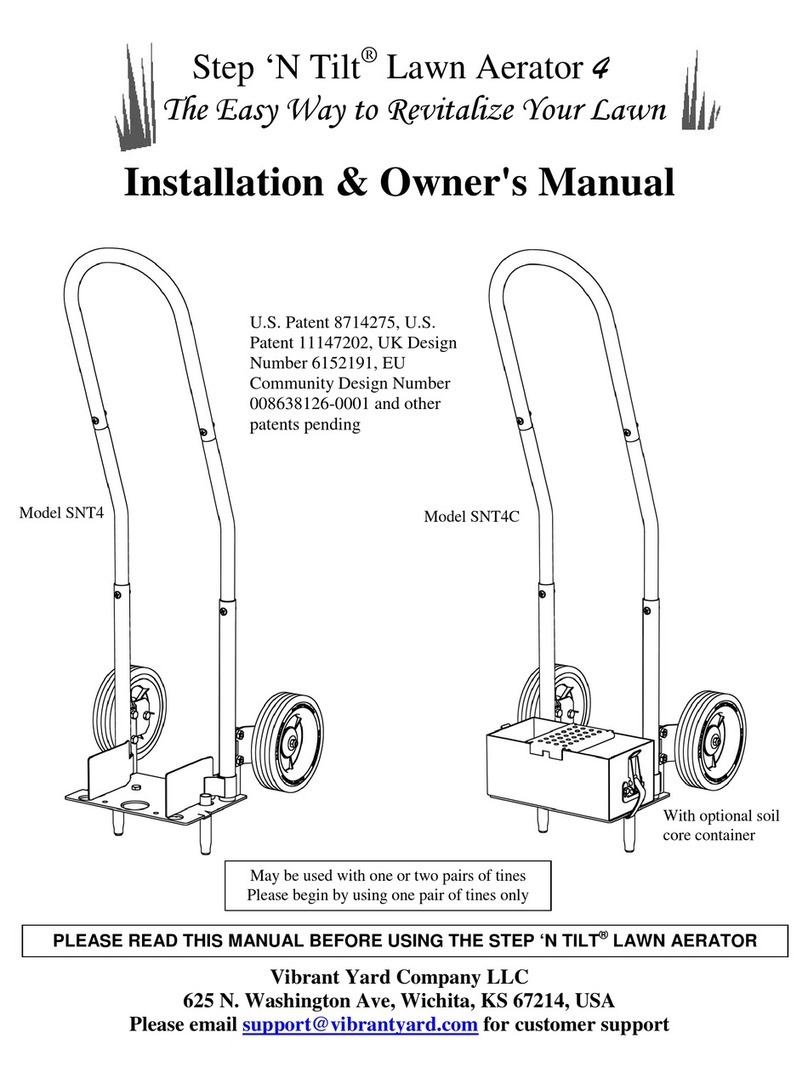
Vibrant Yard
Vibrant Yard Step 'N Tilt Lawn Aerator 4 Installation & owner's manual

Craftsman
Craftsman 944.628654 owner's manual
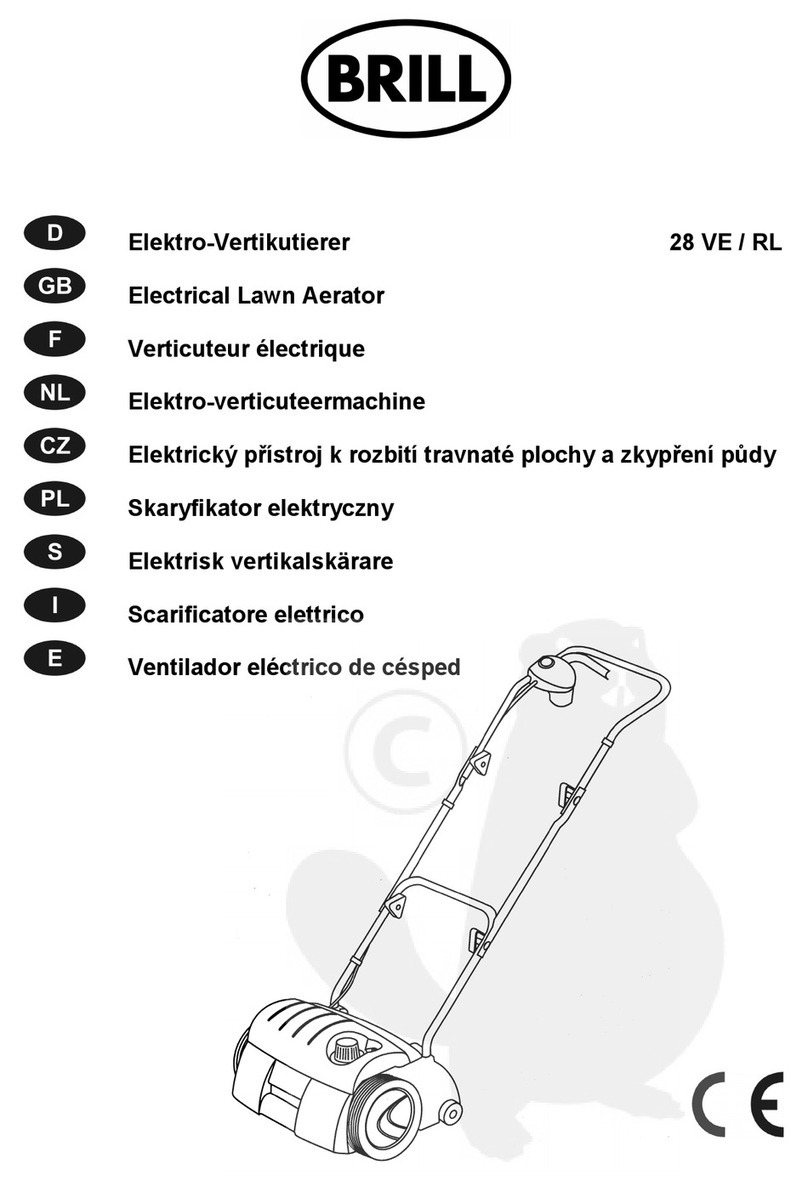
Brill
Brill 28 VE manual
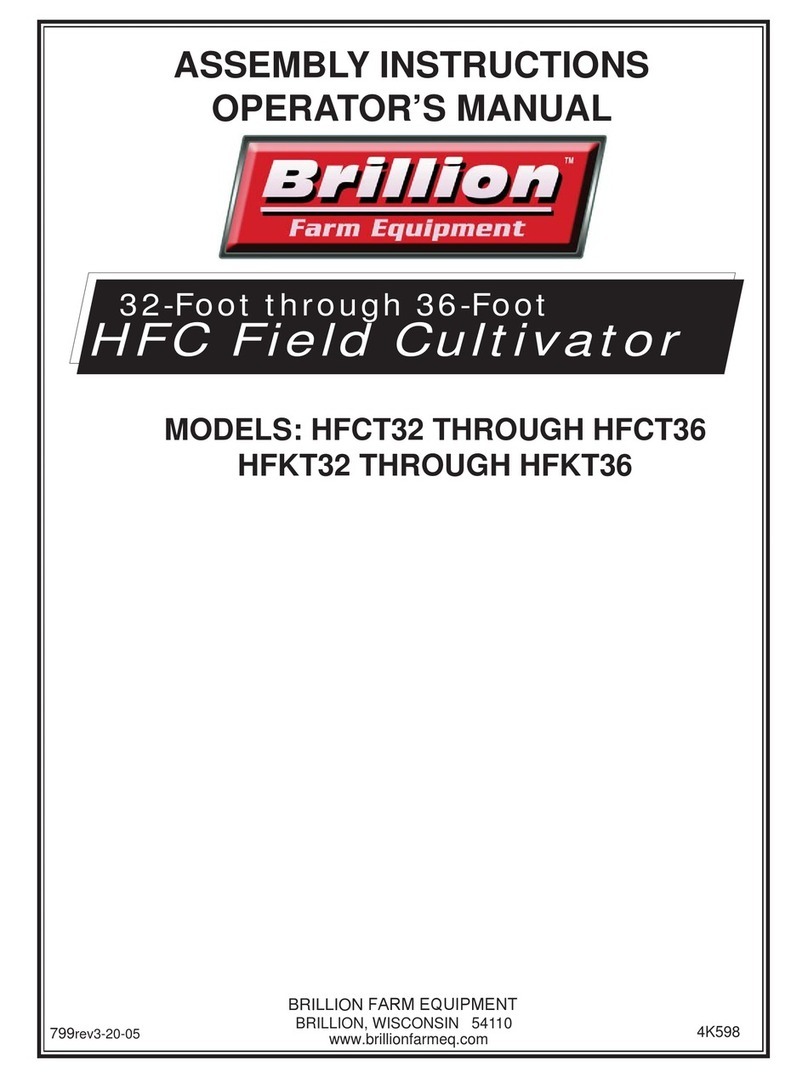
Brillion
Brillion HFC Series Assembly instructions operator's manual
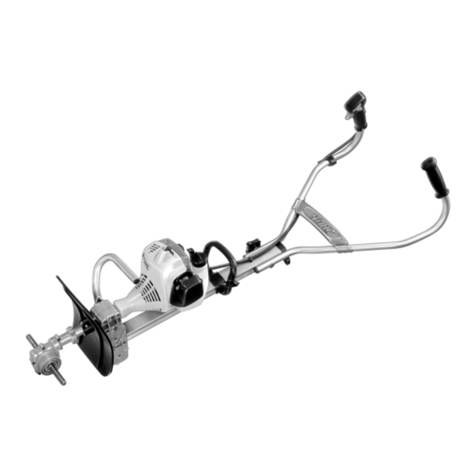
Stihl
Stihl MM 55 instruction manual

MTD
MTD 214-200A Owner's operating service instruction manual


